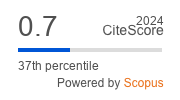Exfoliative Cytological Changes in Peritoneal Fluid from Patients on Peritoneal Dialysis
Keywords:
Cytology,, Peritoneal fluid, DialysisAbstract
Background: Ambulatory peritoneal dialysis
introduced by Popvich et al (13) in 1978 , consists of a
four to five hours lavage of peritoneal cavity with 2000
ml of glucose solution .It remains a useful method for
treating patients with end stage renal failure till renal
transplantation becomes possible.
Objectives: The aim of the study is to evaluate the
value of cytological changes of mesothelial cells in
dialysate patients.
Methods: Within one year period, 32 cytological
peritoneal fluid samples were collected from patients
with end stage renal failure regardless of the underlying
causes, admitted to the dialyzing unit in Kadimya
Teaching Hospital. Smears were prepared and fixed in
95 % ethyl alcohol and then stained with H & E stain to
be interpreted by the same pathologist.
Results: Thirty two samples of peritoneal fluid were
obtained from patients in peritoneal dialysis with a
mean age of 54.8 years and male to female ratio of
about 1.9: 1.
Twenty two had short term dialysis were compared with
10 patients with long term dialysis.
Gross examination of the samples revealed clear yellow
fluid. Macroscopical examination showed no evidence
of inflammatory cells with increased exfoliation,
cellularity and three dimensional mesothelial cellular
clustering pattern with increased nuclear size. No
statistical significances were found in the changes seen
in cytological smears between both groups but
remarkable nuclear changes were shown in both of
them.
Conclusion: This study demonstrated that peritoneal
dialysis of any duration can induce significant atypical
changes in mesothelial cells. The pathologist needs to
be aware of these changes and to include peritoneal
dialysis in the list of other benign conditions that cause
reactive mesothelial atypia













